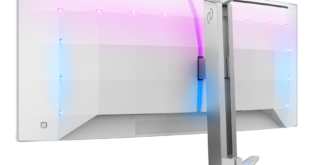AOC and MMD’s Paul Butler looks at enabling on screen privacy.
In today’s world data security is more important than ever before. Educational, financial, medical, governmental organisations are increasingly transitioning to the digital world, where the data needs to be secured with various layers of encryption and with controlled user access. However, one of the largest concerns in terms of security is non-digital forms of hacking.
Non-digital hacking, you ask? Well, in the old days, confidential documents were locked up and only selected, authorised people had access to them. Physical keys and locks were good enough safety measures. Such secured data included health records filed with doctors or hospitals, records of employees, financial documents or highly confidential government or military-specific information. Today, with the digital transformation such documents are kept digitally, with a highly secure IT infrastructure managing and controlling access to these data.
What is often overlooked, however, is “visual hacking”. Theoretically, when a workstation or an account is used by one specific person, no other people without their specific password could access this account. But the reality is much more complex than that. When a customer, another colleague, or a random person physically comes near the workstation, they can see with their own eyes what’s on the screen, even if they’re not authorised by the digital security system.
The point is, even with a multi-layered security system, sometimes what people see as simple hardware such as displays can be a point of failure and compromise the company’s or institution’s confidential data.
For increased viewing comfort, the best monitors we use for our workstations today have viewing angles wide as 178° horizontally, so the colour and contrast shift is kept to a minimum. However this also means that bystanders can also see what’s on the display when standing in this radius.
So at Philips we have come up with a very sleek solution for this issue. We developed a privacy monitor, the Philips 242B1V which has a built-in “Privacy mode”. It comes with all the specs you would need from a business display but what makes this monitor unique is its privacy switch.
Once activated, a special filter limits the horizontal viewing angles from 178° to 90°, while also reducing the brightness to 180 cd/m². In this mode, only people that are straight on looking to the monitor can see the content it displays. After dealing with sensitive data, it can be easily deactivated – a simple but genius solution to a modern and serious problem.
Another form of visual hacking affects passwords. Let’s assume a user is taking their security seriously and the OS is secured by a password when they are away from their desk. This means when they want to login, they will have to physically type their password, which can be watched and recorded from afar. A really dangerous but common practice as well is using the same password for multiple logins. Once stolen these cases present even more serious security risks.
Just like today’s smartphones are increasingly secured by biometric features (facial recognition or fingerprint readers) and less by entering a passcode, the same security paradigm is being applied to laptops and desktop PCs. So, at Philips we simply built this feature into several of our monitors.
Models from Philips monitors that come with webcams featuring Windows Hello support (such as the Philips 346P1CRH for instance) offer easy integration of face recognition to the existing systems.
Additionally, the webcam can be physically tucked away behind the panel when not in use which also eliminates the need for the primitive “post-it over the webcam” situation to physically block the camera, that we see often in offices all over the country.
Security as a concept should not only cover the digital domain, but the physical domain as well, and Philips monitors offer great tools for enterprises and institutions to handle these weaknesses gracefully.
Read the latest edition of PCR’s monthly magazine below:
Like this content? Sign up for the free PCR Daily Digest email service to get the latest tech news straight to your inbox. You can also follow PCR on Twitter and Facebook.
 PCR Tech and IT retail, distribution and vendor news
PCR Tech and IT retail, distribution and vendor news



